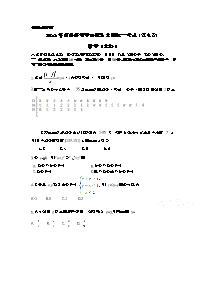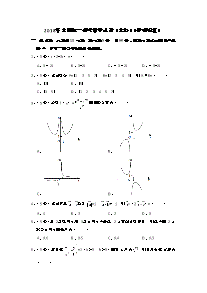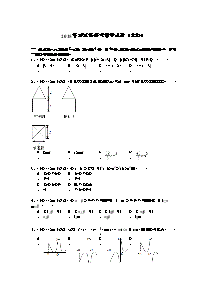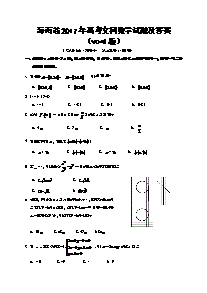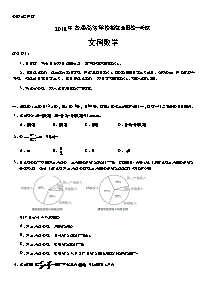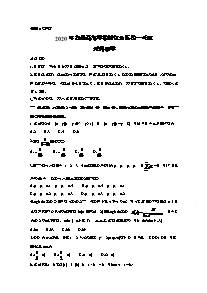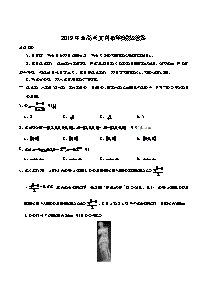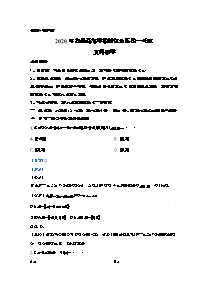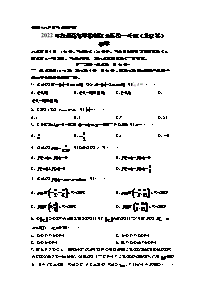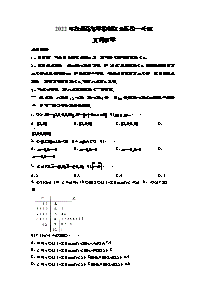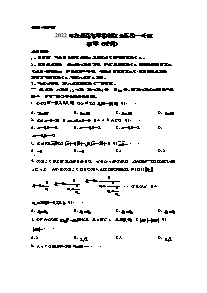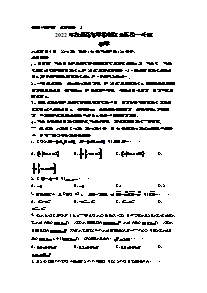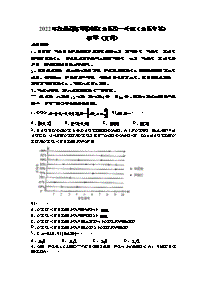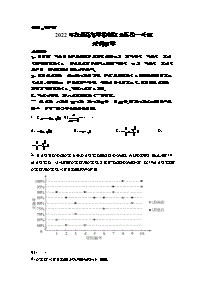英 语
第一部分 听力(共两节,满分 30分)
做题时,先将答案标在试卷上。录音内容结束后,你将有两分钟的时间将试卷上的答案
转涂到答题纸上。
第一节 (共5 小题:每小题 1.5 分,满分 7.5 分)
听下面5 段对话。每段对话后有一个小题,从题中所给的A 、B、C 三个选项中选出最
佳选项。听完每段对话后,你都有 10 秒钟的时间来回答有关小题和阅读下一小题。每段对
话仅读一遍。
例:How much is the shin?
A. 19.15. B. 9.18. C. 9.15.
答案是C 。
1. What does the man do?
A. A computer technician. B. A hotel receptionist. C. A shop assistant.
2. Where does the conversation take place?
A. At the grocer’s. B. At the tailor’s. C. At the cleaner’s.
3. How did the speaker come to Seattle?
A. By plane. B. By car. C. By train.
4. What will the speakers have for dinner today?
A. Fried rice. B. Noodles. C. Steak.
5. How is Sophie feeling now?
A. Confused. B. Worried. C. Disappointed.
第二节 (共 15 小题:每小题 1.5 分,满分 22.5 分)
听下面5 段对话或读白。每段对话或独白后有几个小题,从题中所给的A 、B、C 三个
选项中选出最佳选项,并标在试卷的相应位置。听每段对话或独白前,你将有时间阅读各个
小题,每小题5 秒钟;听完后,各小题将给出5 秒钟的作答时间。每段对话或独白读两遍。
听第6 段材料,回答第6 、7 题。
6. What does the man want to do before noon?
A. Post a letter. B. Make a card. C. Write an email.
7. Whose birthday is it?
A. Richard’s. B. Sarah’s. C. Vera’s.
听第7 段材料,回答第8 、9 题。
8. What course does Professor Brooks teach?
A. Public Speaking. B. European History. C. English Literature.
9. Why does Vicky come to talk with Professor Brooks?
A. To sign up for his course.
B. To ask for a make-up test.
C. To discuss her homework.
听第8 段材料,回答第 10至 13 题。
10. What does Linda do for plays and shows?
A. She gives actors advice.
B. She assigns roles to actors.
C. She designs actors’ clothes.
试题第1 页
11. What does Linda need to research?
A. The setting of the story.
B. The decoration of the stage.
C. The names of the characters.
12. Who does Linda report her work to?
A. The director. B. The editor. C. The photographer.
13. What does Linda say about her job?
A. It pays very well. B. It requires team effort. C. It involves frequent travel.
听第9 段材料,回答第 14至 17 题。
14. What does Kevin think of abstract art?
A. It has lasting artistic value.
B. It makes little sense to him.
C. It appeals mainly to children.
15. What impression did the first painting give the woman?
A. Hopefulness. B. Nervousness C. Coldness.
16. What color was used for the background in the second painting?
A. Green B. Purple. C. Red.
17. What will Kevin probably do this Saturday?
A. Attend an art class. B. Visit an exhibition. C. Buy an abstract painting.
听第 10 段材料,回答第 18至 20 题。
18. What caused the closure of Pittwater Road?
A. A fallen tree. B. A flooded river. C. A car accident.
19. What happened at Town Hall Station?
A. A police officer got hurt.
B. A passenger went missing.
C. The station roof was broken.
20. What are road users advised to do?
A. Drive at low speed. B. Postpone their trips. C. Follow traffic signs.
第二部分 阅读(共两节,满分 50分)
第一节(共 15 小题:每小题 2.5 分,满分 37.5 分)
阅读下列短文,从每题所给的A 、B、C、D 四个选项中选出最佳选项。
A
Tom Sawyer Play Is an Adventure
A 35-minute hand-clapping, foot-stomping musical version of a Mark Twain favorite returns
with this Tall Stacks festival.
“Tom Sawyer: A River Adventure” has all the good stuff, including the fence painting, the
graveyard, the island and the cave. It is adapted by Joe McDonough, with music by David Kisor.
That’s the local stage writing team that creates many of the Children’s Theatre of Cincinnati’s
original musicals, along with the holiday family musicals at Ensemble Theatre.
This year Nathan Turner of Burlington is Tom Sawyer, and Robbie McMath of Fort Mitchell
is Huck Finn.
Turner, a 10th-grader at School for Creative and Performing Arts, is a familiar presence on
Cincinnati’s stages. He is a star actor of Children’s Theatre, having played leading roles in “The
Legend of Sleepy Hollow” and “The Wizard of Oz.” and is fresh from Jersey Production “Ragtime.”
试题第2 页
McMath is a junior at Beechwood High School. He was in the cast of “Tom Sawyer” when it
was first performed and is a Children’s Theatre regular, with five shows to his credit. This summer
he attended Kentucky’s Governor’s School for the Arts in Musical Theatre.
Note to teachers: Children’s Theatre has a study guide demonstrating how math and science
can be taught through “Tom Sawyer.” For downloadable lessons, visit the official website of
Children’s Theatre.
21. Who wrote the music for “Tom Sawyer: A River Adventure”?
A. David Kisor. B. Joe McDonough.
C. Nathan Turner. D. Robbie McMath.
22. What can we learn about the two actors?
A. They study in the same school. B. They worked together in “Ragtime”.
C. They are experienced on stage. D. They became friends ten years ago.
23. What does Children’s Theatre provide for teachers?
A. Research funding. B. Training opportunities.
C. Technical support. D. Educational resources.
B
When was the last time you used a telephone box? I mean to make an actual phone call—not
to shelter from the rain. Ages ago, right? The last time I used a phone box for its intended purpose
was ... 2006. I was conducting auditions (试演) for my play in my tiny old shared house in London.
Hoping to impress some talented actors to come and work for me for nothing, I spread some throws
over the sofas and lit candles to make it seem a bit more “young professional”.
As I rushed outdoors to empty the wastepaper baskets, the door swung shut behind me.
Suddenly I was locked outside. My mobile phone was inside, but luckily there was a telephone box
across the street. So, I called Directory Assistance, got put through to our landlady’s managing agent,
and had a spare key sent to me with just enough time to get bad in before the actors arrived.
As it has been many years since I last used one, I should hardly be surprised that there are no
longer any public telephones near my house. The last one standing has just been turned into a “mini
community library”: any passer-by can “borrow” a book from its shelves, and return it later, or
replace it with another title from their own collection.
For a few months after the “library” opened, I didn’t bother taking a look, as I had assumed
that it would be stuffed full of cheesy love stories. Then I noticed folk conducting spring cleans
dropping boxes of voluminous books on various subjects there. And these books were free. This
unbeatable price-point encouraged me to experiment with dozens of titles that I would never
normally consider buying. And I’ve discovered some great books!
If I ever get trapped outside my house again, my local telephone box will, sadly, no longer be
able to connect me with my keys. But it can certainly keep me entertained while I wait for my wife
to rescue me.
24. What does the word “it” underlined in the first paragraph refer to?
A. The play. B. The shared house.
C. The sofa. D. The telephone box.
25. Why did the author use the telephone box in 2006?
A. To place an urgent call. B. To put up a notice.
C. To shelter from the rain. D. To hold an audition.
26. What do we know about the “mini community library”?
试题第3 页
A. It provides phone service for free. B. Anyone can contribute to its collection.
C. It is popular among young readers. D. Books must be returned within a month.
27. Why did the author start to use the “library”?
A. He wanted to borrow some love stories.
B. He was encouraged by a close neighbour.
C. He found there were excellent free books.
D. He thought it was an ideal place for reading.
C
On September 7, 1991, the costliest hailstorm (雹暴) in Canadian history hit Calgary’ southern
suburbs. As a result, since 1996 a group of insurance companies have spent about $2 million per
year on the Alberta Hail Suppression Project. Airplanes seed threatening storm cells with a chemical
to make small ice crystals fall as rain before they can grow into dangerous hailstones. But farmers
in east-central Alberta — downwind of the hail project flights — worry that precious moisture (水
分) is being stolen from their thirsty land by the cloud seeding.
Norman Stienwand, who farms in that area, has been addressing public meetings on this issue
for years. “Basically, the provincial government is Jetting the insurance, companies protect the
Calgary-Edmonton urban area from hail,” Mr. Stienwand says, “but they’re increasing drought risk
as far east as Saskatchewan.”
The Alberta hail project is managed by Terry Krauss, a cloud physicist who works for Weather
Modification Inc. of Fargo, North Dakota. “We affect only a very small percentage of the total
moisture in the air, so we cannot be causing drought.” Dr. Krauss says. “In fact, we may be helping
increase the moisture downwind by creating wetter ground.”
One doubter about the safety of cloud seeding is Chuck Doswell, a research scientist who just
retired from the University of Oklahoma. “In 1999, I personally saw significant tornadoes (龙卷风)
form from a seeded storm cell in Kansas,” Dr. Doswell says. “Does cloud seeding create killer
storms or reduce moisture downwind? No one really knows, of course, but the seeding goes on.”
Given the degree of doubt, Mr. Stienwand suggests, “it would be wise to stop cloud seeding.”
In practice, doubt has had the opposite effect. Due to the lack of scientific proof concerning their
impacts, no one has succeeded in winning a lawsuit against cloud-seeding companies, Hence,
private climate engineering can proceed in relative legal safety.
28. What does the project aim to do?
A. Conserve moisture in the soil. B. Prevent the formation of hailstones.
C. Forecast disastrous hailstorms. D. Investigate chemical use in farming.
29. Who are opposed to the project?
A. Farmers in east-central Alberta. B. Managers of insurance companies.
C. Provincial government officials. D. Residents of Calgary and Edmonton,
30. Why does Dr. Doswell mention the tornadoes he saw in 1999?
A. To compare different kinds of seeding methods.
B. To illustrate the development of big hailstorms.
C. To indicate a possible danger of cloud seeding.
D. To show the link between storms and moisture.
31. What can we infer from the last paragraph?
A. Scientific studies have proved Stienwand right.
B. Private climate engineering is illegal in Canada.
试题第4 页
C. The doubt about cloud seeding has disappeared.
D. Cloud-seeding companies will continue to exist.
D
The Stanford marshmallow (棉花糖) test was originally conducted by psychologist Walter
Mischel in the late 1960s. Children aged four to six at a nursery school were placed in a room. A
single sugary treat, selected by the child, was placed on a table. Each child was told if they waited
for 15 minutes before eating the treat, they would be given a second treat. Then they were left alone
in the room. Follow-up studies with the children later in life showed a connection between an ability
to wait long enough to obtain a second treat and various forms of success.
As adults we face a version of the marshmallow test every day. We’re not tempted (诱惑) by
sugary treats, but by our computers, phones, and tablets - all the devices that connect us to the global
delivery system for various types of information that do to us what marshmallows do to preschoolers.
We are tempted by sugary treats because our ancestors lived in a calorie-poor world, and our
brains developed a response mechanism to these treats that reflected their value - a feeling of reward
and satisfaction. But as we’ve reshaped the world around us, dramatically reducing the cost and
effort involved in obtaining calories, we still have the same brains we had thousands of years ago,
and this mismatch is at the heart of why so many of us struggle to resist tempting foods that we
know we shouldn’t eat.
A similar process is at work in our response to information. Our formative environment as a
species was information-poor, so our brains developed a mechanism that prized new information.
But global connectivity has greatly changed our information environment. We are now ceaselessly
bombarded (轰炸) with new information. Therefore, just as we need to be more thoughtful about
our caloric consumption, we also need to be more thoughtful about our information consumption,
resisting the temptation of the mental “junk food” in order to manage our time most effectively.
32. What did the children need to do to get a second treat in Mischel’s test?
A. Take an examination alone. B. Show respect for the researchers.
C. Share their treats with others. D. Delay eating for fifteen minutes.
33. According to paragraph 3, there is a mismatch between_______.
A. the calorie-poor world and our good appetites
B. the shortage of sugar and our nutritional needs
C. the rich food supply and our unchanged brains
D. the tempting foods and our efforts to keep fit
34. What does the author suggest readers do?
A. Absorb new information readily. B. Be selective information consumers.
C. Use diverse information sources. D. Protect the information environment.
35. Which of the following is the best title for the text?
A. Eat Less, Read More B. The Biter Truth about Early Humans
C. The Later, the Better D. The Marshmallow Test for Grownups
第二节 (共5 小题:每小题 2.5 分,满分 12.5 分)
阅读下面短文,从短文后的选项中选出可以填入空白处的最佳选项。选项中有两项为多
余选项。
In the past few years, online learning has become a significant part of the university and college
experience. ____36____ But are all online courses created equal? How can you be sure that digital
learning is right for you? ____37____ We interviewed students and professors to get their advice
试题第5 页
about online courses.
The most obvious advantages of online learning is that you can study anywhere and anytime.
____38____ “I think a point that many people lose sight of is how easy it can be to fall behind
schedule,” says graduate student Amanda Bindman. Before choosing to study online, consider
whether you’re a self-motivated learner and if the material seems interesting enough to keep you
going.
The tip that comes up most often is simple: build online courses into your weekly schedule,
just like what you would do with in-person courses. ____39____ He noted that his online students
usually end up with lower grades. It is so easy to let an online course slide, but your grades will
suffer as a result. Be sure to schedule set times to watch your lectures, read materials and contribute
to online discussion boards.
____40____ A social connection is often a big part of learning. There are things you can do to
ease this problem. Jessica Pink, an undergraduate student, suggests taking online courses with a
friend, so you can motivate each other to stay on track. You can also find students on the class
discussion board to organize a study group, or schedule in-person meetings with your professor to
discuss course concepts.
A. But that doesn’t mean there aren’t deadlines.
B. Your motivation should be your main concern.
C. Do you know that online courses are also part of your education?
D. Professor Alex Davidson teaches the same course in person and online.
E. The chief complaint about online courses is that they lack human interaction.
F. If you take an online course, what can you do to ensure the best possible grade?
G. A survey found that 29 percent of college students registered for online courses.
非选择题部分
第三部分 语言运用(共两节,满分 30分)
第一节(共 15 小题:每小题1 分,满分 15 分)
阅读下面短文,从每题所给的A 、B、C、D 四个选项中选出可以填入空白处的最佳选
项。
While taking a 20-hour train ride along the edge of the Taklimakan Desert in the northwestern
China, I had the kind of humbling, educational, and above all else, wonderful ___41___ with a local
that all travelers long for. A young Chinese man ___42___ me on the train. My ___43___ friend
spoke virtually no English, so I happily took the ___44___ to practice my Chinese.
Over several hours he would tell me about how he had ___45___ a two-year professional
school to quickly find a job ___46___ highways in order to help support his family. Perhaps most
___47___, however, was the fact that this man spent hours studying every day after hard physical
labor. Without batting an eye he would ___48___ a translated Emerson passage before asking about
the literary influence of American ___49___ as a whole. “And what do you all learn about Russian
authors?” I ___50___ him asking at one point.
It would have been easy to ___51___ my assumptions about this highway builder who had
never been more than a few hundred miles from home. But this highly informed, ___52___, and
admirable person prevented me doing so. In the course of a couple of hours, he ___53___ me just
how much one can gain from ___54___ with an open mind, and a willingness to ___55___ with
locals from all walks of life.
试题第6 页
41. A. experiment B. encounter C. competition D. appointment
42. A. treated B. saved C. lectured D. approached
43. A. true B. so-called C. new D. long-lost
44. A. chance B. advice C. trouble D. right
45. A. visited B. financed C. attended D. founded
46. A. building B. sweeping C. checking D. guarding
47. A. typical B. obvious C. natural D. remarkable
48. A. publish B. quote. copy D. download
49. A. writers B. historians C. workers D. students
50. A. anticipate B. imagine C. recall D. catch
51. A. look into B. rely on C. go over D. deal with
52. A. well-behaved B. multi-skilled C. warm-hearted D. self-educated
53. A. asked B. warned C. showed D. promised
54. A. traveling B. reading C. searching D. teaching
55. A. cooperate B. side C. negotiate D. engage
第二节(共 10 小题:每小题 1.5 分,满分 15 分)
阅读下面短文,在空白处填入1 个适当的单词或括号内单词的正确形式。
The shelves in most supermarkets are full of family-size this and multi-buy that. However, if
you’re shopping for one, buying extra ___56___ (benefit) from price reductions doesn’t make sense.
Either your shopping is then too heavy to carry home ___57___ you can’t use what you’ve bought
while it’s still fresh.
Of course, shops are not charities — they price goods in the way ___58___ will make them the
most money. If most of their customers are happy to buy larger quantities, that’s ___59___ they’ll
promote. But that leaves the solo (单独) customers out of pocket and disappointed.
Many supermarkets are no longer doing “buy one get one free” promotions because of the
____60___ (criticize) that they lead to waste. Consumers prefer money off individual items.
However, though it’s nice to get a few cents off a pack of sausages, it would help even more if they
could sometimes ___61___ (offer) in smaller packs. Even the biggest sausage fan doesn’t want to
eat them every day.
If your supermarket sells loose produce, then buying smaller quantities is easier. Over the last
two years, some supermarkets ___62___ (start) selling chicken or salad in packs ___63___ (design)
with two halves containing separate portions (份 ). Then, when you use one section, ___64___
other stays fresh.
Who knows, perhaps some of the more forward-looking ___65___ (one) may yet come out
with a whole range of “just for you” pack sizes with special offers as well.
第四部分 写作 (共两节,满分 40分)
第一节 满分(15 分)
请你写一篇短文向校英文报“Sports and Health”栏目投稿,向同学们推荐一项适合课间开
展的运动,内容包括:
1. 介绍这项运动;
2. 说明推荐理由。
注意:
1.写作词数应为 80 个左右;
试题第7 页
2.请按如下格式在答题纸的相应位置作答。
Stand Up and Exercise, Everybody!
第二节:
阅读下面材料,根据其内容和所给段落开头语续写两段,使之构成一篇完整的短文。
Eva spent the first week of high school trying to keep her head above water. One of the major
headaches for her was finding her way in the huge school building. It was a six-story building. On
each floor, hallways stretched in four directions, leading to classrooms, laboratories, and teachers’
offices. Somewhere in the building, there was also a library, a cafeteria, and a gym.
Having a poor sense of direction, Eva found it impossible to get around in such a huge building.
All the different hallways and rooms were too much to think about, let alone commit to memory.
She decided that she would memorize where her classes were and then pretend that the rest of the
place didn’t exist.
In her fast P.E. class, Eva was shocked when Coach Pitt announced that everyone had to run
one mile around the track outside. She searched the faces of her classmates for signs of panic. There
was nothing she feared more than having to run a whole mile. To Eva, “a mile” was used to describe
long distances. It was ten miles from her home to her grandfather’s, and that always seemed like a
long way, even in a car!
When Coach Pitt blew his whistle (哨子), Eva figured she would be left in the dust. However,
while some of her classmates edged ahead, others actually fell behind. “It’s just the beginning,” she
thought. “I’ll come in last for sure.”
Soon Eva began to breathe hard, with her heart pounding and legs shaking. Feeling desperate,
Eva started using a mind wick on herself. She stopped thinking about the word “mile.” Instead, she
focused on reaching the shadow east on the track by an oak tree up ahead. Then she concentrated
on jogging to the spot where the track curved (拐弯). After that, she tried to see if she could complete
her first lap. One lap turned into two, then three, then four.
Paragraph 1: When Coach Pitt said “Nice work!” to her at the finish line, Eva was surprised.
Paragraph 2: Eva decided to use the same trick to deal with the school building.
试题第8 页
参考答案(仅供参考)
听力:
1-5:ACACB 6-10:ACBBC 11-15:AABBC 16-20: ABCCB
阅读:
A篇 :ACD B篇 :BABC C篇 :BACD D篇 :DCBD
七选五:
36-40:GFADE
完形填空:
41-45:BDCAC 46-50:ADBAC 51:BDCAD
参考答案:
56. to benefit 57. or 58. that/which 59. what 60. criticism 61. be offered 62. have started 63. designed
64. the 65. ones
试题第9 页


